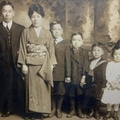
Greg Robinson
@GregGreg Robinson, um nova-iorquino nativo, é professor de História na l'Université du Québec à Montréal, uma instituição de língua francesa em Montreal, no Canadá. Ele é autor dos livros By Order of the President: FDR and the Internment of Japanese Americans (Harvard University Press, 2001), A Tragedy of Democracy; Japanese Confinement in North America (Columbia University Press, 2009), After Camp: Portraits in Postwar Japanese Life and Politics (University of California Press, 2012) e Pacific Citizens: Larry and Guyo Tajiri and Japanese American Journalism in the World War II Era (University of Illinois Press, 2012), The Great Unknown: Japanese American Sketches (University Press of Colorado, 2016) e coeditor da antologia Miné Okubo: Following Her Own Road (University of Washington Press, 2008). Robinson também é co-editor de John Okada - The Life & Rediscovered Work of the Author of No-No Boy (University of Washington Press, 2018). Seu livro mais recente é uma antologia de suas colunas, The Unsung Great: Portraits of Extraordinary Japanese Americans (University of Washington Press, 2020). Ele pode ser contatado no e-mail robinson.greg@uqam.ca.
Atualizado em julho de 2021
Stories from This Author
Parallel Wars: Japanese American and Japanese Canadian Internment Films - Part 1
26 de Janeiro de 2010 • Greg Robinson
This paper examines films that portray the removal and confinement of ethnic Japanese in North America during World War II (often, if imprecisely, called the Japanese internment) through the interactions between Japanese families and white characters, in order to reflect on the ways in which these films are shaped by dominant narratives about race relations. Let me take a moment to explain what I mean about dominant narratives. One eternal dilemma surrounding so-called “message films”; that is, films that deal …
"Two Other Solitudes": Historical Encounters between Japanese Canadians and French Canadians - Part 2
11 de Dezembro de 2009 • Greg Robinson
Part 1 >> This distant attitude would gradually change after the Japanese attack on Pearl Harbor in December 1941. The outbreak of war between Japan and the British Empire unleashed a new wave of anti-Japanese hysteria in British Columbia. White farmers, merchants and political leaders, seizing the opportunity to rid themselves of their long-despised ethnic Japanese competitors, accused the Japanese Canadians of being spies and saboteurs for Tokyo, and called for drastic action to protect the West Coast. In response …
"Two Other Solitudes": Historical Encounters between Japanese Canadians and French Canadians - Part 1
4 de Dezembro de 2009 • Greg Robinson
Les Canadiens à qui on demande en quoi leur pays se distingue des États-Unis devraient répondre en français. (When Canadians are asked what is the difference between their country and the United States, they should answer in French.) —Lester B. Pearson, Prime Minister of Canada, 1963-1968 As an American living in Montreal, I am frequently assigned the task of comparing the United States and Canada, and of reflecting on the particular factors that make life in these two countries, which …
A Tragedy of Democracy: Japanese Confinement in North America - Excerpt Part 3
3 de Novembro de 2009 • Greg Robinson
>> Part 2 The policies designed by the governments of Franklin Roosevelt and Mackenzie King were arrived at independently, with no effective coordination. All the same, the two were similar in their provisions. Indeed, the Canadian experience points strongly to certain conclusions regarding events south of the border. First, military necessity was not the governing factor in the removal of Issei and Nisei. The same arguments were made in British Columbia as in California about ethnic Japanese being fifth-columnists, yet …
A Tragedy of Democracy: Japanese Confinement in North America - Excerpt Part 2
27 de Outubro de 2009 • Greg Robinson
>> Part 1 As important as that initial goal is, this book has a greater purpose: to expand the contours of discussion on Japanese American confinement beyond the overly narrow framework of time and space in which the subject has been placed. First, my history goes beyond the limits of the wartime period in its discussion of events. The main story of confinement properly begins in the prewar years, with the buildup of suspicion against Japanese Americans and “enemy aliens” …
A Tragedy of Democracy: Japanese Confinement in North America - Excerpt Part 1
20 de Outubro de 2009 • Greg Robinson
In the spring of 1942, a few months after the Japanese attack on Pearl Harbor launched World War II in the Pacific, the United States Army, acting under authority granted by President Franklin D. Roosevelt and confirmed by Congress, summarily rounded up the entire ethnic Japanese population living on the nation’s Pacific Coast. These American citizens and longtime residents—some 112,000 men, women, and children—were packed into military holding centers for several weeks or months and then transported under armed guard …








